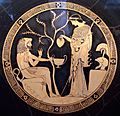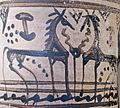Dorian Invasion facts for kids
The Dorian invasion is a theory about how a group of ancient Greek people, called the Dorians, might have moved into different parts of Ancient Greece. Many historians believe this event could have played a part in a big historical change known as the Bronze Age Collapse.
Contents
What was the Bronze Age Collapse?
The Bronze Age Collapse was a time of great trouble and change around 1200 BC. Many powerful civilizations in the Mediterranean region suddenly fell apart. Cities were destroyed, trade stopped, and writing systems were lost. It was a mysterious period where many things that people relied on disappeared.
Why did the Bronze Age Collapse happen?
Historians aren't completely sure why the Bronze Age Collapse happened. There are many ideas, like natural disasters, climate change, or even other invasions. The idea of the Dorian migration is one of the theories that tries to explain some of these changes in Greece.
Who were the Dorians?
The Dorians were one of the main groups of ancient Greeks. They spoke a specific dialect of the Greek language, called Doric Greek. Later, famous Greek cities like Sparta were founded by Dorians.
Where did the Dorians come from?
It's believed that the Dorians originally lived in the northern parts of Greece. Over time, they might have moved south into areas where other Greek groups, like the Mycenaeans, lived.
The Idea of the Dorian Migration
The idea of a "Dorian invasion" or "migration" suggests that these people moved into southern Greece. This movement might have been a slow migration over many years. Or it could have been a faster, more forceful invasion.
What evidence supports this idea?
One main piece of evidence is the change in Greek dialects. After the Bronze Age, the Doric dialect became common in southern Greece. This suggests that people speaking Doric moved into these areas. Also, some archaeological findings show new types of pottery and burial customs appearing. These changes might be linked to new groups of people arriving.
Changes in pottery and tools
After the Bronze Age, a new style of pottery called "protogeometric" appeared. This pottery was simpler than the earlier Mycenaean styles. Some historians think this change shows new people with different traditions. Iron tools also became more common during this time.
Why is it called a "theory"?
It's called a theory because there isn't clear written evidence from that time. Most of what we know comes from archaeology and later Greek stories. These stories, like those about the "Return of the Heracleidae," might be ancient legends about the Dorians moving south.
Impact of the Dorian Migration
If the Dorian migration happened, it would have had a huge impact on ancient Greece.
End of the Mycenaean Civilization
The Mycenaean civilization was very powerful before the Bronze Age Collapse. They built large palaces and had a complex society. The arrival of the Dorians might have contributed to the end of this civilization.
Beginning of the Greek Dark Ages
After the collapse, Greece entered a period called the "Greek Dark Ages." During this time, writing was lost, and many large settlements were abandoned. The Dorian migration is seen by some as a key event leading to this period.
New social structures
The Dorians brought their own social structures and ways of life. Their arrival might have led to the formation of new city-states, like Sparta. These new societies were often different from the older Mycenaean ones.
Modern Views on the Dorian Migration
Today, historians still debate the exact nature of the Dorian migration. Some believe it was a major event that caused widespread destruction. Others think it was a slower, more peaceful movement of people. There's also a view that it wasn't a single event, but many smaller movements over time.
Is it still taught in schools?
Yes, the Dorian migration is still taught as an important theory in ancient Greek history. It helps explain some of the big changes that happened after the Bronze Age. However, students also learn that it's a complex topic with ongoing research and different ideas.
Images for kids
-
Heracles and Athena. an Attic red-figure vase.
-
A record of Pylos, preserved by baking in the fire that destroyed the palace about 1200 BC, according to the excavator, Carl Blegen. The record must date to about 1200, as the unbaked clay, used mainly for diurnal or other short-term records, would soon have disintegrated.
-
The northern (to south) Dorian migration in H.G. Wells' The Outline of History (1920).
-
Geometric pottery, Dorian Argos.
See also
 In Spanish: Invasión dórica para niños
In Spanish: Invasión dórica para niños







